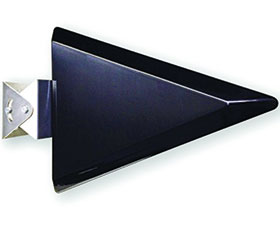

Taoglas launched the Engager logarithmic periodic dipole antenna (LPDA) series. This wideband directional antenna series offers high gain at multiple frequencies, including for the first time an LPDA antenna that can cover all cellular 2G/3G and 4G LTE bands globally – for all carriers and networks.
High-gain directional antennas are used for point-to-point applications and also for devices at remote sites or areas of low signal strength. In these areas of low signal strength, traditionally many installers have helped the device get connectivity by changing the internal or cabled antenna to a high-gain directional antenna that is mounted on the outside of the building on a pole or wall. The installer would ascertain the location of the cellular base station and point the antenna directly towards it. The higher gain can help get connectivity when a standard omnidirectional antenna that is on the device would not.
According Dermot O’Shea, Taoglas joint CEO, the Engager antennas eliminate the need for Yagis. “The Yagis are also directional and high-gain but are limited to a narrow bandwidth or single frequency,” he explains. “That means if you installed an antenna for a base station belonging to a certain carrier at a certain time, that frequency or base station equipment can be changed over time, meaning you have to go back on site and change the antenna. That scenario can happen over and over again but with the Engager series it’s a one-time installation and future proofs the site’s connectivity for many years.“
The company’s other CEO, Ronan Quinlan, points out the Engager’s particular applicability to the South African market: “Leading IoT gateway device manufacturers need wideband LTE antenna products to cater for the ever expanding LTE bands such as at 450 MHz in the Nordic countries, or for more unusual bands such as at 2300 MHz in South Africa,” he notes.
“They were simply not being catered for before by traditional antenna suppliers who can’t keep up with the pace of technological change in the wireless industry. But with our global engineering presence in all key markets we also know LTE antennas need to be ready for use at the re-designated
600 MHz frequencies, and on the 2,4 GHz and 5 to 6 GHz unlicensed bands. The patent pending Engager line will enable our customers to leap years ahead of the competition, delivering much enhanced throughput and reliability to end users.”
The antennas are available with wall- or pole-mount options. The wall-mount option consists of a two-part bracket, allowing it to be tilted and rotated and hence pointed in the required direction of the base station. The pole-mount bracket is delivered with u-bolts and clamps, and when secured on the pole itself it can also be tilted 30 degrees above or below horizontal to make it even easier for the installer to get the right location. The weatherproof, ASA-housing antennas have been rated to a wind resistance of 200 kmph.
For more information contact Andrew Hutton, RF Design, +27 (0)21 555 8400, [email protected], www.rfdesign.co.za
| Tel: | +27 21 555 8400 |
| Email: | [email protected] |
| www: | www.rfdesign.co.za |
| Articles: | More information and articles about RF Design |

© Technews Publishing (Pty) Ltd | All Rights Reserved